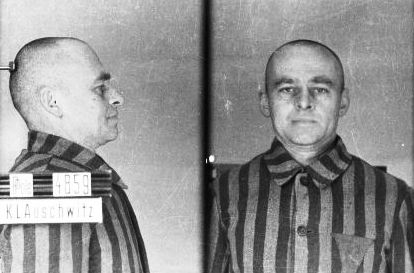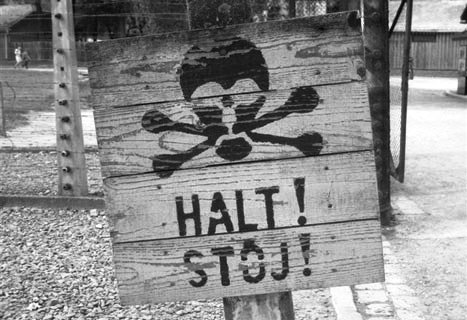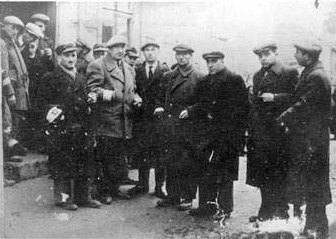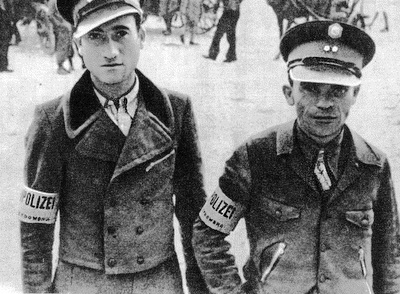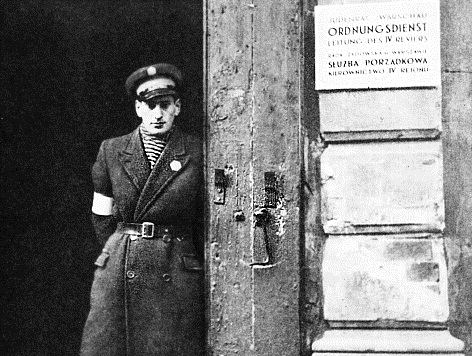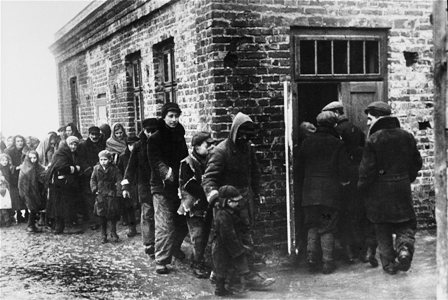Holocaust Education & Archive Research Team |
|
Occupation German Occupation of Europe Timeline
-
[The Occupied Nations]
Poland Austria Belgium Bulgaria Denmark France Germany Greece Hungary Italy Luxembourg The Netherlands Norway Romania Slovakia Soviet Union Sudetenland
| |||||
POLISH FORT-NIGHTLY REVIEW London, Saturday, November 15th 1941, Issue No. 32 "The Real New Order - Terror " Part 2 Oswiecim Concentration Camp & The Jewish Ghetto In Warsaw [photos added to enhance the text]
OSWIECIM
Poles are Incarcerated in concentration camps at Oswiecim, Oranienburg - Sachsenhausen, Mauthausen, Dachau, Ravensbrucke (for women) and in several other smaller camps. Most of the prisoners are drawn from the intellectual classes. Certificates from public departments or public utility undertakings are no security whatever against arrest. The prisoners are often taken away without coats and hats, even in the coldest of weather.
They are usually transported in sealed railway trucks, seventy persons to each. Frequently the trucks, after sealing, are left standing on a siding until there are sufficient to make up a train, and cases have been known of prisoners being left thus sealed up on the siding for four or even six days, not provided With food or water or warm clothing and bedding, at a, time of deep frost. When the prisoners stamped their feet and moved about to keep warm, the guards struck their rifle butts on the sides of the trucks and ordered them to be quiet. But in any case, after a couple of days or so the prisoners did not need telling to be quiet.
Blinded, numbed with cold, hungry, and dizzy with the sudden fresh air, they are unable to. step out immediately, and the police help them out with rifle butts and kicks. The older men fall and slide down the ramp. Prisoners unable to get up from. the floor of the truck are dragged out by their feet or hands and flung down the ramp. The corpses are left in the truck, and are afterwards burnt in the crematorium. The prisoners are then packed into lorries, being beaten incessantly all the while.
On arrival at the camp they are ordered to fall in line in order of size. Those who cannot stand are laid out on the, ground. After the list has been checked, which usually takes a couple of hours or more they are, allotted to the various barracks. The barracks are unheated, and there are innumerable chinks in the walls. At one time a man was hanged over the door of one of the barracks, and his body was left hanging for some time.
'He was one of a group who planned to organize a hunger strike in protest against prisoners being driven out to work dressed, only in wet overalls during frosts. There is so little room for sleeping that if any prisoner turns over he disturbs his neighbors. There is only one palliasse for every three prisoners.
All towels have to be kept in a single heap so that no prisoner has his own towel and the danger of infectious disease is greatly increased. Many persons suffering from venereal diseases are deliberately sent to the camp.
Rising time is about 5 a.m., and three minutes are allowed for washing under a cold shower, cleaning clothes, and dressing. Sick prisoners must work as though they were quite well. No one may report sick unless he has a temperature of over 100.4 Fahrenheit. If anyone reports sick with a lower temperature he is sent to the punishment squad. The prisoners live in dread of illness, as there is no proper medical care for them.
The jailers in charge of the barracks are chiefly criminals who have been given life sentences, but among them are a couple of German Communists. The jailers are degenerates, and have absolute sway over the lives of the prisoners in their charge. The prisoners are forced to do exhausting labor, frequently entirely useless. On one occasion a group of five men, including two priests, was ordered to do stone breaking. One of them tried to warm his hands by clasping them against his body, and the guard sentenced him to stand with his hands above his head for half an hour. While performing their task they were not allowed to kneel or squat down.
When one of the priests, an old man; knelt down to pick up the hammer head which had come off the handle, the guard ran up and kicked the priest so hard that the blood came. One group of prisoners was given heavy blocks of wood, with which they bad to smooth the surface of stone blocks which were to be used for sculpture.
A medallion with a stamp of the Blessed Virgin slipped out of the open neck of one mans shirt, and a Gestapo man at once ran up, kicked him in the face, tore the medallion away and ordered him to eat it.
Another group was ordered to construct a pond. As the prisoners may not ruin their boots or socks, they were ordered to work barefoot in the snow and on the frozen mud. All the prisoners of this group were from the intellectual class. One day they were unable to stand any more, and attacked their two guards, trampling them in the. mud.
The next day a large number of prisoners were taken out to the open field and ordered to run. The guards opened fife from machine-guns. Those who were killed were at once cremated. In the centre of the camp is a square used as a place for punishment exercise. In the middle of the square is a post. One day some fifteen men had to perform special gymnastics consisting of squatting and rising at the order of a Gestapo man behind them.
The prisoners held one another's hands so that the stronger could help the weaker. This kind of exercise is continued for hours at a time. The Gestapo men in charge are changed, but the prisoners have to go on. Frequently prisoners can be seen pushing wheelbarrows loaded with stones around the square at the double. Behind them a guard rides on a cycle using a whip on those who do not keep running. Prisoners frequently die on this exercise, as no one has yet succeeded in running round the circle more than 25 times.
The food has to be consumed in a very short, fixed period, and when instead of soup they are given potatoes in their jackets they have to eat the skins as well, as they have no time to peel them. Large numbers suffer from digestive troubles, and they suffer all the more because they are allowed to use the toilet only three times a day.
The gate was open, and he could run out into freedom. But as stealing was a punishable offence, he must first run the gauntlet of the two rows of guards. He started to run between the lines, being beaten mercilessly on the head and legs with the knouts. Near the end of the line he began to stagger, but he summoned up all his strength and ran out through the gate. Then a machine-gun opened fire, and he was wounded in the belly. The guards called to a man with a wheelbarrow working close by, threw the wounded man on the barrow and ordered him to be taken to the crematorium.
The prisoner was sufficiently conscious to see where he was being taken, and in a frenzy of despair tried to say something to the crowd of guards watching the sight. But they only laughed and made their way to the crematorium. There he was thrown into the furnace, where there were already two half-burnt bodies. The sight of his struggles aroused only jeers an d laughter among the onlookers. The two guards in charge or the crematorium were ordered to divide the ashes into three, as the last victim had moved and so had disturbed the ashes of the other bodies.
During this period 86 men died wider the torture. In order to lengthen the period of torture, when any prisoner swooned he was carried under a pump and, brought round by having water pumped over him, and then was returned to the line to be beaten.
Theoretically, they are divided into three groups: political prisoners, criminals, and priests and Jews. This last group is the one worst treated, and no member of the group leaves the camp alive. Every month-the Warsaw postal authorities send out several hundred notices of deaths of people in Oswiecim. During last winter the mortality in the camp was terribly high, an average of 70 to 80 persons dying every day. On one day 156 people died. Even the Germans were forced to arrange for the inspection of the camp by a sanitary commission, after which the mortality fell somewhat, and during the spring and summer was some 30 daily. During the winter months three crematorium furnaces were insufficient to cope with the bodies to be cremated.
"Neutral zone. Anyone crossing this line will be fired on without warning."
The work of the Jewish Council is divided among several administrative departments, and is also in control of the "Order Guard" (Jewish Police), as well as a special institution for supplies, now being organized' in the form of a limited liability co-operative. There is a treasury office for the quarter, concerned with collecting State taxes and also acting as the local executive office, which at present is transmitting all receipts from communal taxes to the treasury of the Warsaw city administration.
Apparently this arrangement is to be altered, but for the time being the Jewish Council, which in principle has taken on the obligation of local government, derives no receipts from taxation in the strict sense of the word. It meets its financial needs from a main levy, identical for all inhabitants, and also from a graduated levy, the rate of which depends on the payer's financial position.
It also makes single payment levies at irregular intervals. However, these levies provide insufficient funds to meet the Council's requirements, in view of the terrible need which prevails in the community.
The ghetto population at present numbers between 510.000 and 520,000, of which 240,000 are listed as indigent and have to be maintained from community funds. But by no means all this number is being assisted, as the very small quantity of food allowed enables the community to issue only some 120,000 portions of soup, barely half the quantity required.
The individual rations allowed on ration cards are completely inadequate, consisting as they do of only 2,500 grams (not quite 6 Ibs.) of bread and 180 grams (less than a 1/2lb.) of sugar per month. All other food must be bought on the open market, which is supplied exclusively with smuggled goods, as the import of food, fuel., etc., into the ghetto is officially prohibited.
In such conditions, food prices in the Jewish ghetto are far higher than prices in the Aryan quarters. At the end of May the following prices prevailed: Bread, 3.25 zlotys a kilogram;. potatoes, 8.50 zlotys a kilo: butter (almost unobtainable), 100 zlotys a kilo, lard, 80 zlotys a kilo. (The prewar rate was 25 zlotys, to one pound sterling.) The prices of other commodities have not risen quite so steeply, and as the largest wholesalers in Warsaw are situated in the ghetto area there is a brisk sale for goods smuggled out into the Aryan quarters.
Needless to say, all trade with the Aryan quarters is on an illegal basis, as all commerce between the ghetto and the outside world is possible only through the intermediary of a special German department, given the official title of Transferstelle. This department for settlements exists solely for the purpose of acting as intermediary in the purchase of goods from the Jewish quarter. It collects a commission of from 10 to 25 percent on all transactions, and the sums paid into the department for individual Jewish accounts are not paid out to the rightful recipients.
Moreover, by the nature of things this administrative method of conducting commerce is completely unsuited to trading activities, and so not only do Jews and Poles avoid resorting to it, but even Germans, and especially the military authorities, ignore it. The military place orders or make purchases directly in the ghetto, paying the sum due in cash to the vendor, although this is legally prohibited. The material position of the Jewish population is extraordinarily, difficult, especially as only some 4,000 craftsmen and workers are engaged in the community workshops on, orders placed by the German authorities.
The majority of these workers are tailors, hatters, and some shoemakers. As maw more are working on military requirements. Some 50,000 people are living by illegal trade, i.e., by smuggling. The remainder do their best to live by such activities as catering for municipal needs, speculation, and so on, but in the main they are unemployed. The richer people are still selling jewelry and valuables, but there are not many such left, while the poor are dying of hunger and the increasingly incidence of illness, especially heart and lung affections.
None the less, the population of the ghetto is steadily increasing, as Jews are continually being brought in from the provincial towns, where the Germans do not intend to set up separate Jewish quarters. Some 9,000 people have been taken for forced labor, chiefly in connection with river conservancy and improvement schemes. This low figure is explained by the circumstances that comparatively few Jews are suitable for heavy physical labor. Every day the bodies of people who have died under this labor are brought in (on an average twenty daily) while the dangerously ill are sent away for treatment.
The labor conditions under this forced labor, and even the living conditions in the barracks and state of food supplies, are terrible. The treatment meted out to the Jews by the camp guard, who consist mainly of Ukrainians, is also very bad. In the ghetto itself a 'Polish police service is organized, but its members are specially chosen for their task.
The Jewish "order guard'" does not concern itself with the suppression of crime, which is a function of the Polish police. German uniformed police take no active part in control inside the ghetto, and they are concerned only with guarding its boundaries. But the Gestapo functions in the ghetto through secret agents among the Jews, as well as under the cover of a special station for combating illegal trade.
Apparently the explanation of this is that the Warsaw ghetto is an experiment on which all Jewish existence throughout Europe is to modeled in, the future when the New Order has been introduced. It must be emphasized that the Warsaw ghetto is the only completely closed Jewish quarter in all the General Government.
Where Jewish quarters have been· established elsewhere, they are only a zone in which Jews are permitted to settle; but Aryans are not forbidden access to them as in Warsaw, while the Jews also can move freely about the entire town: or at least are granted passes to leave the confines of the ghetto. In the areas incorporated within the Reich the Jews of certain towns are still living in far better (conditions than those of Warsaw).
In consequence, from 400 to 500 people secretly escape from the Warsaw ghetto every day and try to get into the provinces, even into the incorporated areas, returning to the places from which they have been deported or going to towns where they have relations, etc. Outside Warsaw the only closed Jewish quarter in the Polish territory is at Lodz. This ghetto has been in existence much longer than the Warsaw ghetto, and so the conditions in which the Jews live have had much greater effect on their health.
During the first three weeks of May last 1,080 Jews died in Lodz out of 150,000, while there were only eight births. This extremely high mortality is a consequence of the prevailing conditions. In Lodz the entire Jewish population is fed in communal kitchens.
The German Commissar for the Jewish quarter in Warsaw has taken the Lodz organization of communal feeding as a model, and has put forward a proposal for the organization of similar feeding centers in Warsaw, to be accompanied by the abolition of individual domestic feeding.
Sources:
The National Archives KEW The Chris Webb Archive Public Records Office, London Polish Museum in the United Kingdom Holocaust Historical Society US NARA USHMM
Copyright Carmelo Lisciotto H.E.A.R.T 2011
|
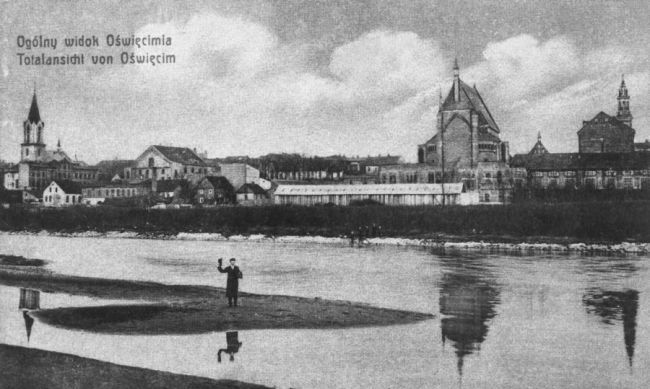
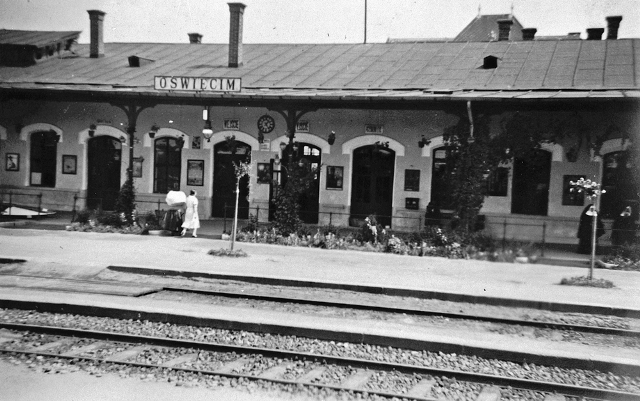
.jpg)
